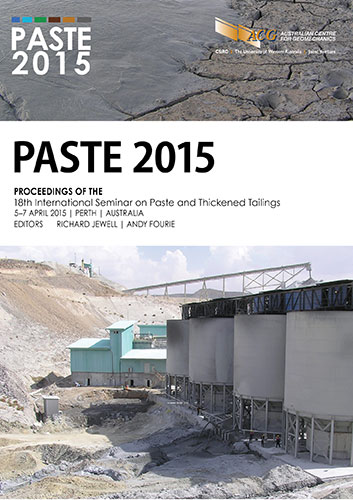Risk assessment methodology for paste and thickened tailings

|
Authors: Fernandez-Iglesias, A; Correa, A; Morton, O; Laine, J; Luiña, R; Martinez, G |
DOI https://doi.org/10.36487/ACG_rep/1504_11_Fernandez-Iglesias
Cite As:
Fernandez-Iglesias, A, Correa, A, Morton, O, Laine, J, Luiña, R & Martinez, G 2015, 'Risk assessment methodology for paste and thickened tailings', in R Jewell & AB Fourie (eds), Paste 2015: Proceedings of the 18th International Seminar on Paste and Thickened Tailings, Australian Centre for Geomechanics, Perth, pp. 167-180, https://doi.org/10.36487/ACG_rep/1504_11_Fernandez-Iglesias
Abstract:
According to the database compiled by the US Commission on Large Dams (USCOLD) and completed later by the International Commission on Large Dams (ICOLD) and the US Environmental Protection Agency (EPA), there have been two or more major tailing dam failure incidents per year between 1970 and 2000, proving that these catastrophic failure events are not rare occurrences. Paste and thickened tailings (P&TT) technology has emerged in recent years as a promising technique to avoid dam incidents. Due to the low water content of the P&TT, the potential for liquefaction is reduced drastically in comparison to conventional tailing dams. This is one of the major advantages of the technology, alongside the volume reduction and the absence of bleed water. However, paste also has some drawbacks such as higher energy consumption and extra equipment requirements. Due to these advantages and drawbacks, a set of different tools is required to assess the feasibility of a paste facility at a specific mine. Among these tools, those related to risk become important since one of the major advantages of paste is related to this dimension. Thus, selecting the right tool for analysis is a key factor in the decision-making process that may lead to the selection of P&TT as an alternative to conventional tailings storage. According to the AS/NZS 4360:2004 ‘Risk Management’ (Standards Australia 2004), developing a risk assessment involves a three-stage process: identify, analyse and evaluate all the risks involved. The best tool to provide structure for these stages is a failure modes and effect analysis (FMEA) of the tailings system. In the present work, a general comparison between P&TT and conventional tailings storage has been made in terms of risk, using a FMEA based on a classification of likelihood and consequences in a semi-quantitative risk assessment. All risks for stages from the concentration plant onwards are considered for each scenario, in two different categories: environmental and public safety. Paste and thickened tailings technology has more risks classifying as low to moderate than conventional tailings and has less risks classifying as moderate to high area. These results can be used as an indication of the sustainability of P&TT disposal in terms of risks. Although the goal of the study is to make a general comparison not applied to any specific mine, it can also be used as a methodology or template for a risk assessment for any existing installation.
References:
Aguilar, J, Dorronsoro, C, Fernández, E, Fernández, J, García, I, Martín, F, Ortiz, I & Simon, M 2000, El desastre ecológico de Aznalcóllar, Universidad de Granada, viewed 20 September 2014,
Davies, M, Martin, T & Lighthall, P 2000, ‘Mine tailings dams: when things go wrong’, Proceedings of Tailings Dams 2000, Association of State Dam Safety Officials, U.S. Committee on Large Dams, pp. 261-273.
Department of Resources Energy and Tourism (RET) 2008, Risk assessment and management, RET, Canberra.
Department of Resources Energy and Tourism (RET) 2007, Tailings management, RET, Canberra.
Doka, G 2009, Life cycle inventory data of mining waste: emissions from sulfidic tailings disposal, Doka Life Cycle Assessments, Zürich.
Dold, B 2008, ‘Sustainability in metal mining: from exploration, over processing to mine waste management’, Reviews in Environmental Science and Bio/Technology, vol. 7, no. 4, pp. 275-285.
Engels, J 2013, Conventional impoundment storage - the current techniques, University of Leeds, viewed 09 September 2014,
European Neighbourhood Partnership Instrument (Eastern Region) [ENPI East] 2011, Waste governance - ENPI East: methodology for the environmental & health risk assessment of mine tailings disposal sites, ENPI East, Kyiv.
International Commission on Large Dams (ICOLD) & United Nations Environmental Programme (UNEP) 2001, Bulletin 121: tailings dams - risk of dangerous occurrences, lessons learnt from practical experiences, ICOLD & UNEP, Paris.
Rausand, M, & Høyland, A 2003, System reliability theory: models, statistical methods, and applications, Wiley-Interscience, Hoboken.
RET 2007, ‘Tailings management’, Canberra Australia Government, Commonwealth of Australia.
Robertson, MG & Shaw, S 2003, Risk management for major geotechnical structures on mines, Robertson GeoConsultants Inc., Vancouver, viewed 11 March 2015, www.rgc.ca/files/publications/cami03risk.pdf
Robinsky, EI 1999 ‘Tailings dam failures need not be disasters: the thickened tailings disposal (TTD) system’, CIM Bulletin, vol. 92, no. 1028, pp. 140-142.
Sachan, C 2010, ‘New Directions in Tailings Management’, in The Organizing Committee of the 14th International Conference on Tailings and Mine Waste, Proceedings of Tailings and Mine Waste, pp. 41-48.
Standards Australia 2004, AS/NZS 4360:2004 Risk Management, Standards Australia, Sydney.
Wennberg, T 2010, ‘Transporting highly concentrated slurries with centrifugal pumps: the thickened minerals tailings example’, Licentiate thesis, Luleå tekniska universitet, Luleå. Licentiate thesis / Luleå University of Technology .
Xenidis, A, Papassiopi, N & Komnitsas, K 2003, ‘Carbonate-rich mining tailings in Lavrion: risk assessment and proposed rehabilitation schemes’, Advances in Environmental Research, vol. 7, no. 2, pp. 479-494.
Xin, Z, Xiaohu, X & Kaili, X 2011 ‘Study on the risk assessment of the tailings dam break’, Procedia Engineering, vol. 26, pp. 2261-2269.
© Copyright 2025, Australian Centre for Geomechanics (ACG), The University of Western Australia. All rights reserved.
View copyright/legal information
Please direct any queries or error reports to repository-acg@uwa.edu.au
View copyright/legal information
Please direct any queries or error reports to repository-acg@uwa.edu.au